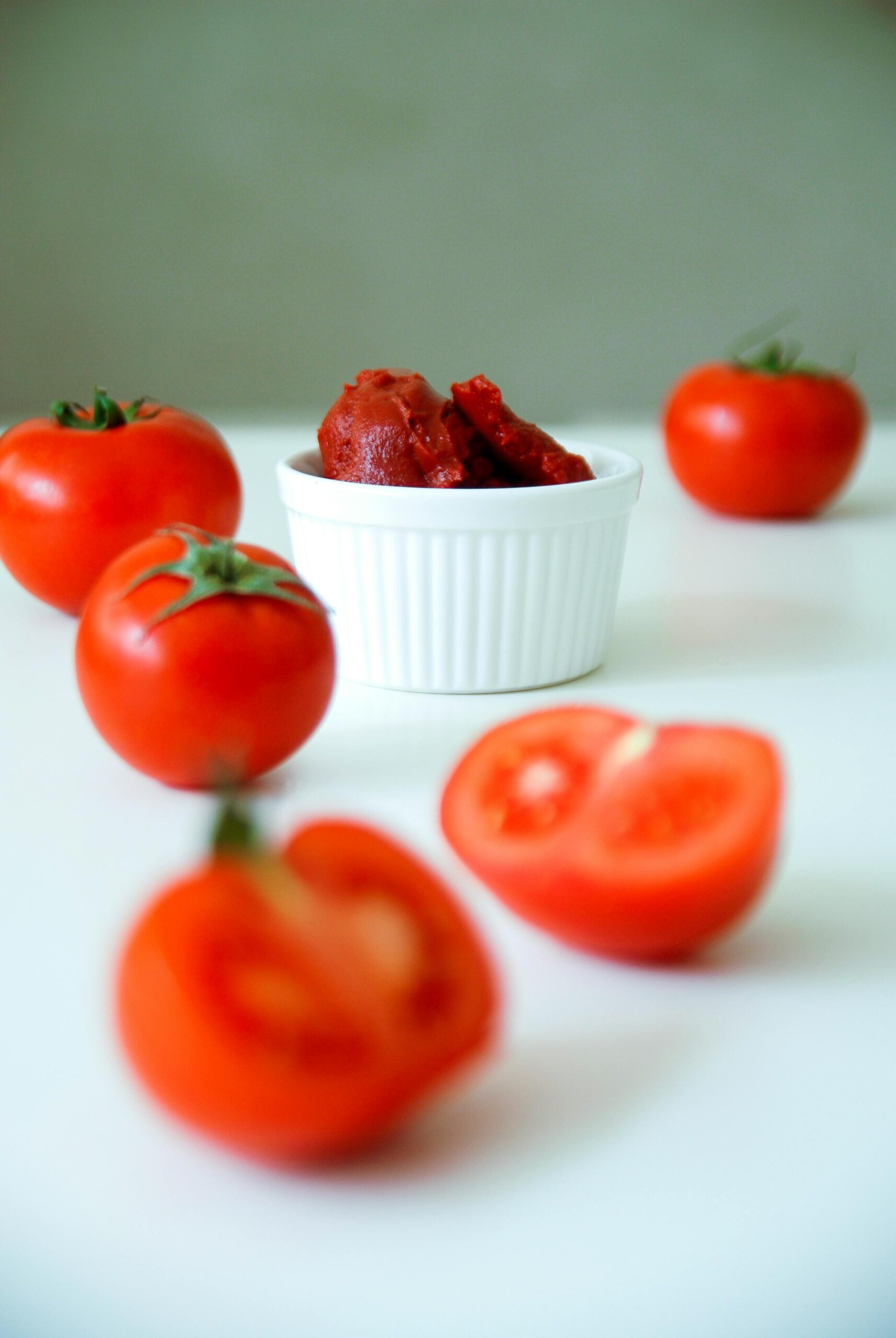There are two ways to source tomato paste: use fresh tomatoes to prepare homemade tomato paste or purchase a can from a grocery store. Whichever type you prefer, you will most likely end up with a sizeable portion of leftover tomato paste.
If the leftover paste is used within a couple of days of opening the can, the chances of spoilage are minimal, provided you refrigerate the can once opened.
Although, in all likelihood, we have come across opened cans of tomato paste and wondered if they are past the date of safe consumption.
In this article, we look at this versatile ingredient that is a staple in pasta dishes, stews, soups, and much more. We will understand the factors affecting its shelf life and share tips on proper storage so you can get the most out of every scoop and reduce wastage. We will also look at ways to tell if a batch of tomato paste has gone bad.
How Long Does Tomato Paste Last in the Fridge?
Tomato paste is made from crushed tomatoes that are cooked, sieved (to remove skin and seeds), and evaporated to yield a thick, red-colored paste that can be diluted with other liquids to make homemade pasta sauce, ketchup, chili, or stew; or added to dishes such as shepherd’s pie or meatloaf for a concentrated burst of tomato flavor.
Unlike processed items like tomato ketchup, mayo, or soy sauce, which contain preservatives and stabilizers to enhance their shelf stability, tomato paste has a significantly lower shelf life.
It is one of those pantry staples that must be used up or stored properly after opening.
Unopened tomato paste
An unopened, store-bought can of tomato paste can last up to 1-3 years from the date of manufacture. This information is readily available on the cans as ‘Best before’ or ‘Best if used by’ dates and usually indicates the period during which the tomato paste will retain its top quality and taste.
Opened tomato paste
However, once you open a can of tomato paste, it must be refrigerated to maintain freshness. Depending on how it has been stored, tomato paste can stay fresh for up to 5-7 days. On the other hand, tomato paste in tubes lasts much longer: up to 45 days after opening. That said, several other factors affect its quality and longevity.
Proper Tomato Paste Storage Guidelines
Tomato paste comes packaged in cans, tubes, jars, and Tetra Pak cartons. When it comes to storing any leftover product, canned tomato paste must be transferred to a glass or food-grade plastic container and closed properly before refrigeration.
On the other hand, tomato paste in tubes and Tetra Pak cartons need not be emptied into another container. This is because tubes and cartons allow little exposure to air as compared to cans. However, refrigeration is a must.
If you are unsure about using up the leftover tomato paste within 5-7 days, you can freeze it. Although any freezer-safe container works, it is helpful to portion out the leftover paste in ice-cube trays before freezing it. You can then transfer the cubes into a ziplock bag and keep it sealed for freshness. Next time a recipe calls for tomato paste, just pop a cube or two and you’re done!
Another of our favorite tricks is to transfer the tomato paste to a ziplock bag, flatten it out to remove any air, seal it, and create individual portions by drawing partitions using a spoon or chopstick across the length of the bag.
When stored in a freezer, tomato paste can keep safe indefinitely, although you should use it within four months to get the best flavor.
Factors Affecting Shelf Life
Knowing the factors that impact the shelf life of a product is key to understanding and implementing storage best practices and ultimately reducing the wastage of food. Three main factors affect how long tomato paste stays safe and fresh. Interestingly, these factors often work together.
Exposure to Air and Light
One of the main factors that shortens the shelf life of tomato paste is oxidation. When exposed to air, the ascorbic acid (Vitamin C) present in tomato paste reacts with oxygen, causing the paste to turn brown. This is where mold begins to form, eventually.

Commercially produced tomato paste is sealed in cans or tubes to prevent oxidation. However, once a can is opened, its contents begin to deteriorate quickly. To slow down this process, it is essential to transfer any leftover product into another container with a tight-fitting lid leaving as little room for air as possible.
In terms of reducing exposure to air, tubes perform better than cans and jars. Owing to their design, tubes allow very little air to get inside, which improves the shelf life of tomato paste. On the flip side, they can be costlier to purchase than canned paste. If you use tomato paste often, it makes better sense to purchase a canned product and store the remnants separately.
Let’s talk about exposure to light. Placing a container of tomato paste in direct sunlight or near a sunny window can heat it up, which could result in an increase in microbial activity and, in the case of glass jars, a change in the color of the product.
Packaging
Another reaction happens when the metal content of a can reacts with the acid present in tomato paste to produce hydrogen. While this reaction is limited in the absence of oxygen, an opened can of tomato paste can sustain this corrosive process, contaminating the tomato paste with iron/tin present in the can.
This is another reason why canned food items, especially high-acid foods, must always be stored in a closed, non-metallic container after opening.
Interestingly, however, unopened tomato paste in metal cans is better insulated from air, light, and heat than in tubes and jars. So, if you plan to stock up on tomato paste for the longer term, consider purchasing cans instead of jars or tubes.
Temperature
A critical factor that influences shelf life is temperature. Cooler temperatures prevent microbial activity. This is why manufacturers recommend storing sealed containers of tomato paste in a cold, dark place. An opened container must always be refrigerated.
Tomato paste that is kept consistently at sub-zero temperatures will stay safe for consumption.
Signs of Spoilage
It is essential to learn to identify spoiled tomato paste before you accidentally add it to a dish. Not only does spoiled tomato paste make a dish unpalatable, but it also poses a serious health risk.
Microorganisms such as fungi and bacteria can easily multiply in such an environment, which could lead to severe bouts of food poisoning.
Three reliable indicators can be used to determine if tomato paste is spoiled: mold, foul odor, and a change in appearance.
Mold Growth
Mold growth is one of the main causes of spoiled tomato paste.
Mold thrives in a humid, acidic environment, which is typical of tomato paste. Mold spores can be introduced at any time during the processing, storage, or packing of tomato paste, which is beyond a consumer’s control except when the paste is homemade.
If you think sealed packets would get rid of mold, think again. Mold needs very little oxygen to survive and can easily multiply once a can or jar is opened and exposed to air. However, keeping the container tightly closed and refrigerated will inhibit mold growth to a large extent.
Mold appears in the form of fuzzy, greenish spots or patches on the surface of tomato paste. Even if you scrape the mold off the top, its spores could be dispersed through the product.
So, if you suspect mold contamination, it is better to discard the entire contents of the container.
Off Odor
Producers of packaged tomato paste use the freshest tomatoes picked at peak ripeness. This imparts a sweet scent and a rich, concentrated flavor to the tomato paste, which indicates its freshness.
However, spoiled tomato paste often emits a rancid odor and tastes bitter or sour.
When evaluating tomato paste for signs of spoilage, it is important to trust your senses: any off-putting smell indicates the presence of harmful microorganisms or the breakdown of natural enzymes, even if there are no visual indicators yet.
Change in Color or Texture
Tomato paste has a natural deep red color that turns darker when spoiled. This is often the result of oxidation and exposure to air; whereas, the appearance of spots or discoloration on the surface could indicate that mold is beginning to form.
Sometimes, tomato paste becomes watery; this means the product is no longer at top quality, although it is still safe to consume.
Insider’s Insight
Among sealed products, tomato paste in cans has the longest shelf life of 1-3 years when stored in a cool, dark environment.
To ensure leftover tomato paste stays fresh for as long as possible, it is essential to store it properly. Canned paste must be transferred to a glass or plastic container with a tight-fitting lid with little room for air and kept refrigerated. Stored this way, tomato paste will stay fresh for 5-7 days.
Tomato paste in tubes lasts up to 45 days under refrigeration due to minimum exposure to air. However, they are more expensive than canned products.
If you intend to store the leftover product for longer, you can freeze it in ice-cube trays or ziplock bags. Kept frozen, tomato paste stays safe indefinitely, even though it might not retain its fresh flavor.
To determine if a batch of tomato paste is good for consumption, check for signs of mold growth on the surface. Other indicators include rancid odor, bitter or sour taste, and discoloration or browning on the top. You should immediately discard an unopened can that is bulging or shows signs of rust, as these are likely to be contaminated with metal from the can.
We hope this information comes in handy the next time you plan to make your favorite chili or stew recipe. Happy cooking!






Leave a Reply